Health Psychology: Assessment and Theory Evaluation of Tracey's Case
VerifiedAdded on 2020/04/13
|12
|3525
|44
Essay
AI Summary
This essay delves into the field of health psychology, focusing on the assessment and intervention strategies for a 36-year-old female named Tracey. The essay begins with a needs analysis of Tracey, identifying key risk factors such as obesity, unhealthy eating habits, lack of physical activity, and a family history of diabetes. These factors contribute to her complaints of lethargy, low mood, and dissatisfaction with her weight. The analysis explores the interplay of lifestyle, sociocultural, and psychosocial factors influencing Tracey's health. The essay then evaluates the application of psychological theories, including the Social Cognitive Theory and the Health Action Process Approach (HAPA) model, to address Tracey's behavioral issues. It discusses how these theories can be used to promote an active lifestyle and improve her overall well-being. The essay highlights the strengths and limitations of each theory in the context of Tracey's case, emphasizing the importance of tailored interventions to achieve desired health outcomes. The role of a health psychologist in assessing behavior and promoting health is critically examined.
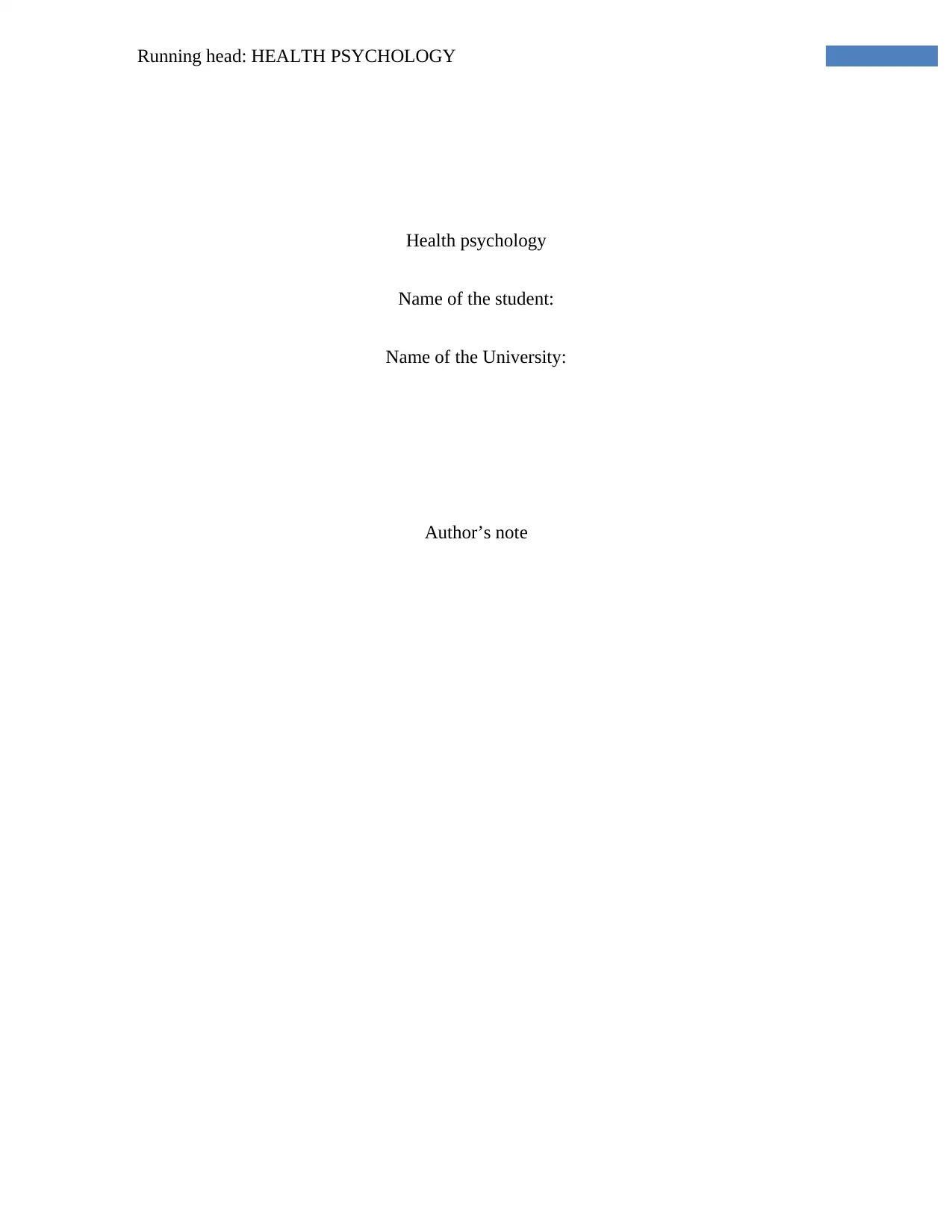
Running head: HEALTH PSYCHOLOGY
Health psychology
Name of the student:
Name of the University:
Author’s note
Health psychology
Name of the student:
Name of the University:
Author’s note
Paraphrase This Document
Need a fresh take? Get an instant paraphrase of this document with our AI Paraphraser
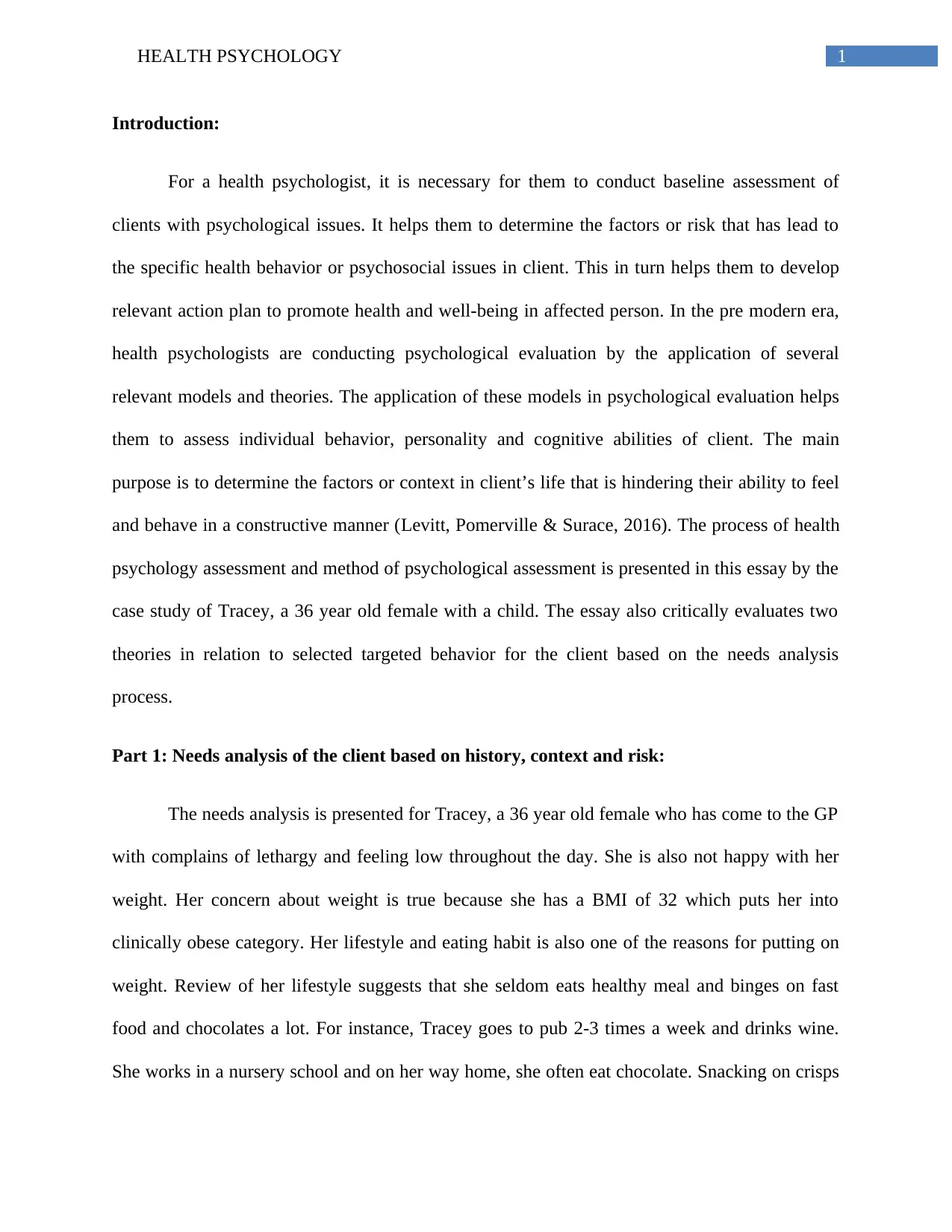
1HEALTH PSYCHOLOGY
Introduction:
For a health psychologist, it is necessary for them to conduct baseline assessment of
clients with psychological issues. It helps them to determine the factors or risk that has lead to
the specific health behavior or psychosocial issues in client. This in turn helps them to develop
relevant action plan to promote health and well-being in affected person. In the pre modern era,
health psychologists are conducting psychological evaluation by the application of several
relevant models and theories. The application of these models in psychological evaluation helps
them to assess individual behavior, personality and cognitive abilities of client. The main
purpose is to determine the factors or context in client’s life that is hindering their ability to feel
and behave in a constructive manner (Levitt, Pomerville & Surace, 2016). The process of health
psychology assessment and method of psychological assessment is presented in this essay by the
case study of Tracey, a 36 year old female with a child. The essay also critically evaluates two
theories in relation to selected targeted behavior for the client based on the needs analysis
process.
Part 1: Needs analysis of the client based on history, context and risk:
The needs analysis is presented for Tracey, a 36 year old female who has come to the GP
with complains of lethargy and feeling low throughout the day. She is also not happy with her
weight. Her concern about weight is true because she has a BMI of 32 which puts her into
clinically obese category. Her lifestyle and eating habit is also one of the reasons for putting on
weight. Review of her lifestyle suggests that she seldom eats healthy meal and binges on fast
food and chocolates a lot. For instance, Tracey goes to pub 2-3 times a week and drinks wine.
She works in a nursery school and on her way home, she often eat chocolate. Snacking on crisps
Introduction:
For a health psychologist, it is necessary for them to conduct baseline assessment of
clients with psychological issues. It helps them to determine the factors or risk that has lead to
the specific health behavior or psychosocial issues in client. This in turn helps them to develop
relevant action plan to promote health and well-being in affected person. In the pre modern era,
health psychologists are conducting psychological evaluation by the application of several
relevant models and theories. The application of these models in psychological evaluation helps
them to assess individual behavior, personality and cognitive abilities of client. The main
purpose is to determine the factors or context in client’s life that is hindering their ability to feel
and behave in a constructive manner (Levitt, Pomerville & Surace, 2016). The process of health
psychology assessment and method of psychological assessment is presented in this essay by the
case study of Tracey, a 36 year old female with a child. The essay also critically evaluates two
theories in relation to selected targeted behavior for the client based on the needs analysis
process.
Part 1: Needs analysis of the client based on history, context and risk:
The needs analysis is presented for Tracey, a 36 year old female who has come to the GP
with complains of lethargy and feeling low throughout the day. She is also not happy with her
weight. Her concern about weight is true because she has a BMI of 32 which puts her into
clinically obese category. Her lifestyle and eating habit is also one of the reasons for putting on
weight. Review of her lifestyle suggests that she seldom eats healthy meal and binges on fast
food and chocolates a lot. For instance, Tracey goes to pub 2-3 times a week and drinks wine.
She works in a nursery school and on her way home, she often eat chocolate. Snacking on crisps
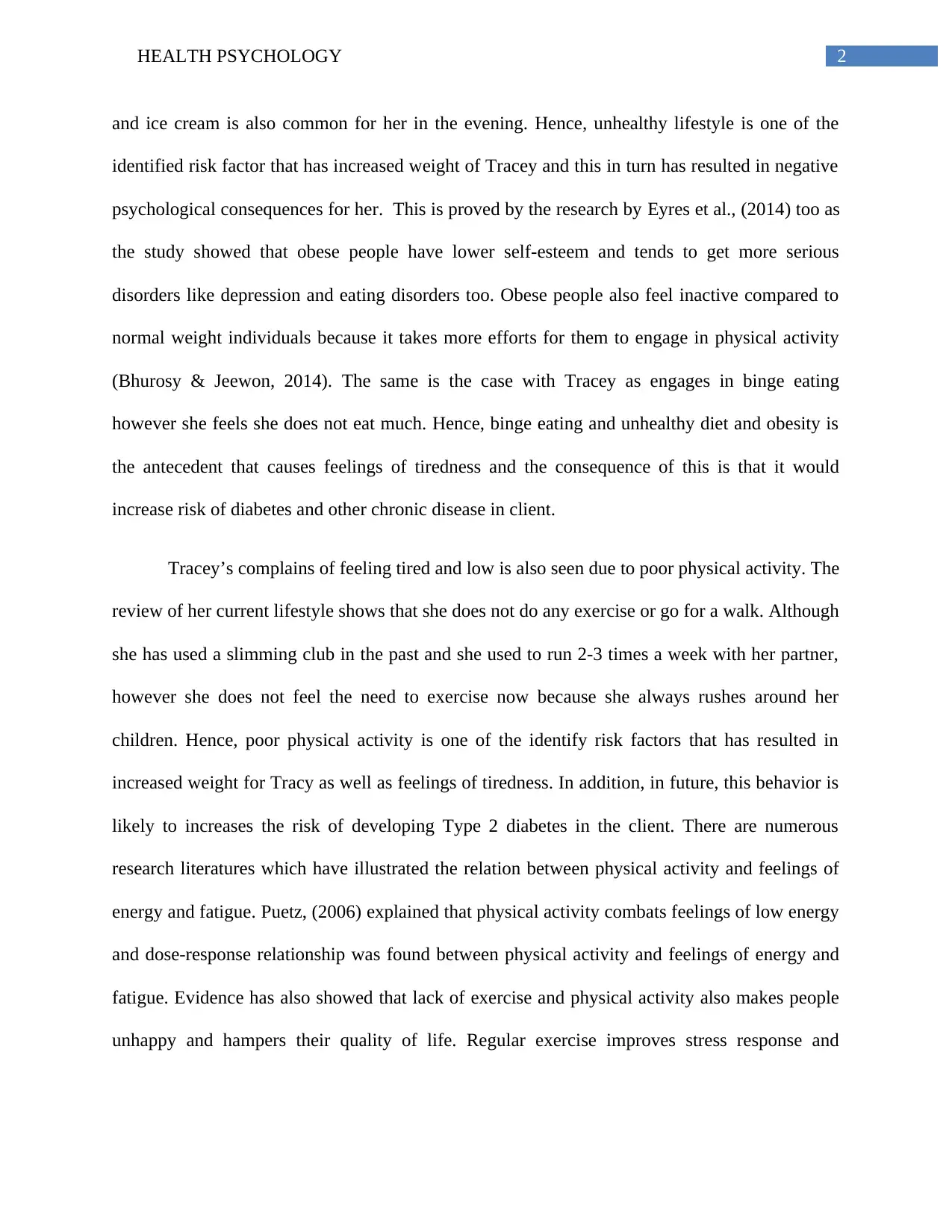
2HEALTH PSYCHOLOGY
and ice cream is also common for her in the evening. Hence, unhealthy lifestyle is one of the
identified risk factor that has increased weight of Tracey and this in turn has resulted in negative
psychological consequences for her. This is proved by the research by Eyres et al., (2014) too as
the study showed that obese people have lower self-esteem and tends to get more serious
disorders like depression and eating disorders too. Obese people also feel inactive compared to
normal weight individuals because it takes more efforts for them to engage in physical activity
(Bhurosy & Jeewon, 2014). The same is the case with Tracey as engages in binge eating
however she feels she does not eat much. Hence, binge eating and unhealthy diet and obesity is
the antecedent that causes feelings of tiredness and the consequence of this is that it would
increase risk of diabetes and other chronic disease in client.
Tracey’s complains of feeling tired and low is also seen due to poor physical activity. The
review of her current lifestyle shows that she does not do any exercise or go for a walk. Although
she has used a slimming club in the past and she used to run 2-3 times a week with her partner,
however she does not feel the need to exercise now because she always rushes around her
children. Hence, poor physical activity is one of the identify risk factors that has resulted in
increased weight for Tracy as well as feelings of tiredness. In addition, in future, this behavior is
likely to increases the risk of developing Type 2 diabetes in the client. There are numerous
research literatures which have illustrated the relation between physical activity and feelings of
energy and fatigue. Puetz, (2006) explained that physical activity combats feelings of low energy
and dose-response relationship was found between physical activity and feelings of energy and
fatigue. Evidence has also showed that lack of exercise and physical activity also makes people
unhappy and hampers their quality of life. Regular exercise improves stress response and
and ice cream is also common for her in the evening. Hence, unhealthy lifestyle is one of the
identified risk factor that has increased weight of Tracey and this in turn has resulted in negative
psychological consequences for her. This is proved by the research by Eyres et al., (2014) too as
the study showed that obese people have lower self-esteem and tends to get more serious
disorders like depression and eating disorders too. Obese people also feel inactive compared to
normal weight individuals because it takes more efforts for them to engage in physical activity
(Bhurosy & Jeewon, 2014). The same is the case with Tracey as engages in binge eating
however she feels she does not eat much. Hence, binge eating and unhealthy diet and obesity is
the antecedent that causes feelings of tiredness and the consequence of this is that it would
increase risk of diabetes and other chronic disease in client.
Tracey’s complains of feeling tired and low is also seen due to poor physical activity. The
review of her current lifestyle shows that she does not do any exercise or go for a walk. Although
she has used a slimming club in the past and she used to run 2-3 times a week with her partner,
however she does not feel the need to exercise now because she always rushes around her
children. Hence, poor physical activity is one of the identify risk factors that has resulted in
increased weight for Tracy as well as feelings of tiredness. In addition, in future, this behavior is
likely to increases the risk of developing Type 2 diabetes in the client. There are numerous
research literatures which have illustrated the relation between physical activity and feelings of
energy and fatigue. Puetz, (2006) explained that physical activity combats feelings of low energy
and dose-response relationship was found between physical activity and feelings of energy and
fatigue. Evidence has also showed that lack of exercise and physical activity also makes people
unhappy and hampers their quality of life. Regular exercise improves stress response and
⊘ This is a preview!⊘
Do you want full access?
Subscribe today to unlock all pages.

Trusted by 1+ million students worldwide
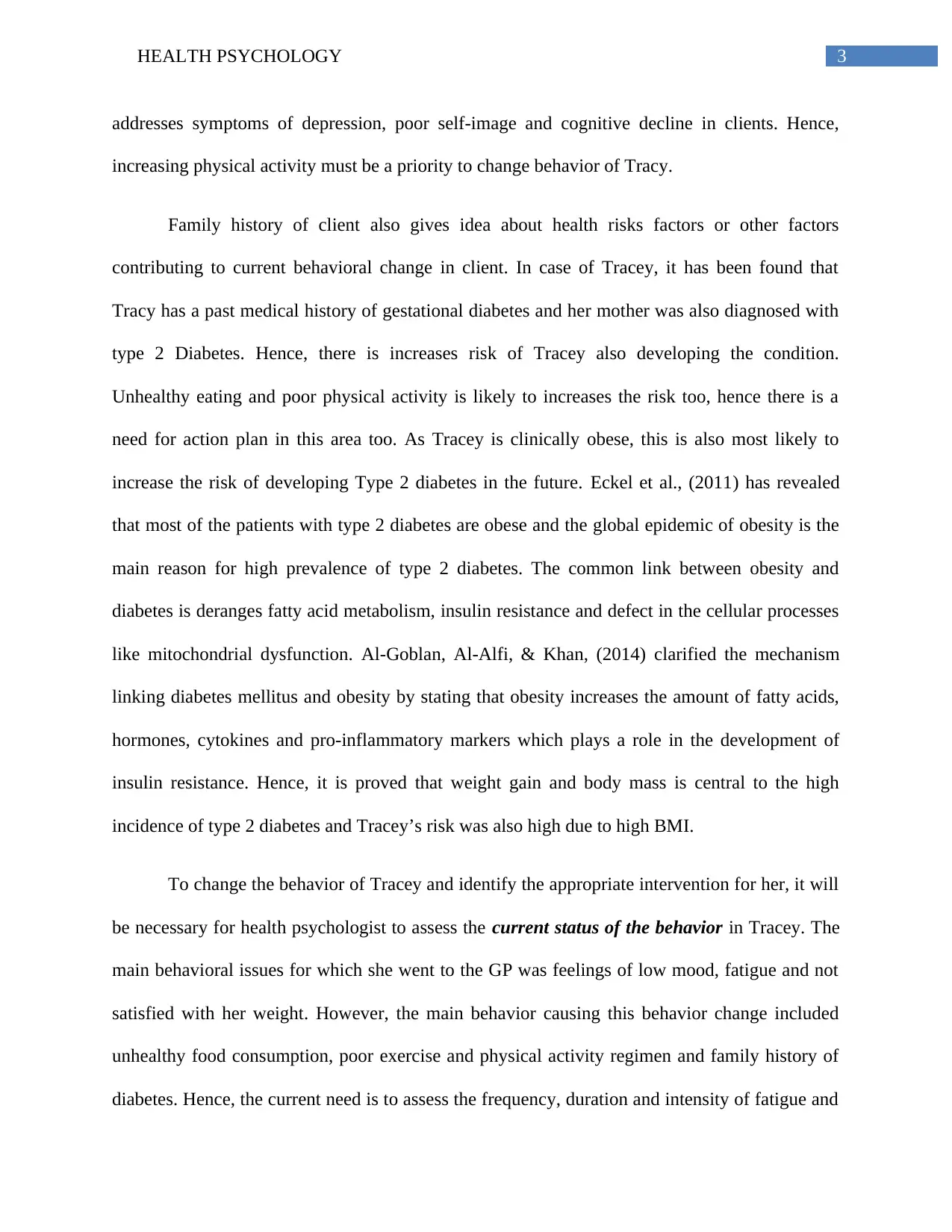
3HEALTH PSYCHOLOGY
addresses symptoms of depression, poor self-image and cognitive decline in clients. Hence,
increasing physical activity must be a priority to change behavior of Tracy.
Family history of client also gives idea about health risks factors or other factors
contributing to current behavioral change in client. In case of Tracey, it has been found that
Tracy has a past medical history of gestational diabetes and her mother was also diagnosed with
type 2 Diabetes. Hence, there is increases risk of Tracey also developing the condition.
Unhealthy eating and poor physical activity is likely to increases the risk too, hence there is a
need for action plan in this area too. As Tracey is clinically obese, this is also most likely to
increase the risk of developing Type 2 diabetes in the future. Eckel et al., (2011) has revealed
that most of the patients with type 2 diabetes are obese and the global epidemic of obesity is the
main reason for high prevalence of type 2 diabetes. The common link between obesity and
diabetes is deranges fatty acid metabolism, insulin resistance and defect in the cellular processes
like mitochondrial dysfunction. Al-Goblan, Al-Alfi, & Khan, (2014) clarified the mechanism
linking diabetes mellitus and obesity by stating that obesity increases the amount of fatty acids,
hormones, cytokines and pro-inflammatory markers which plays a role in the development of
insulin resistance. Hence, it is proved that weight gain and body mass is central to the high
incidence of type 2 diabetes and Tracey’s risk was also high due to high BMI.
To change the behavior of Tracey and identify the appropriate intervention for her, it will
be necessary for health psychologist to assess the current status of the behavior in Tracey. The
main behavioral issues for which she went to the GP was feelings of low mood, fatigue and not
satisfied with her weight. However, the main behavior causing this behavior change included
unhealthy food consumption, poor exercise and physical activity regimen and family history of
diabetes. Hence, the current need is to assess the frequency, duration and intensity of fatigue and
addresses symptoms of depression, poor self-image and cognitive decline in clients. Hence,
increasing physical activity must be a priority to change behavior of Tracy.
Family history of client also gives idea about health risks factors or other factors
contributing to current behavioral change in client. In case of Tracey, it has been found that
Tracy has a past medical history of gestational diabetes and her mother was also diagnosed with
type 2 Diabetes. Hence, there is increases risk of Tracey also developing the condition.
Unhealthy eating and poor physical activity is likely to increases the risk too, hence there is a
need for action plan in this area too. As Tracey is clinically obese, this is also most likely to
increase the risk of developing Type 2 diabetes in the future. Eckel et al., (2011) has revealed
that most of the patients with type 2 diabetes are obese and the global epidemic of obesity is the
main reason for high prevalence of type 2 diabetes. The common link between obesity and
diabetes is deranges fatty acid metabolism, insulin resistance and defect in the cellular processes
like mitochondrial dysfunction. Al-Goblan, Al-Alfi, & Khan, (2014) clarified the mechanism
linking diabetes mellitus and obesity by stating that obesity increases the amount of fatty acids,
hormones, cytokines and pro-inflammatory markers which plays a role in the development of
insulin resistance. Hence, it is proved that weight gain and body mass is central to the high
incidence of type 2 diabetes and Tracey’s risk was also high due to high BMI.
To change the behavior of Tracey and identify the appropriate intervention for her, it will
be necessary for health psychologist to assess the current status of the behavior in Tracey. The
main behavioral issues for which she went to the GP was feelings of low mood, fatigue and not
satisfied with her weight. However, the main behavior causing this behavior change included
unhealthy food consumption, poor exercise and physical activity regimen and family history of
diabetes. Hence, the current need is to assess the frequency, duration and intensity of fatigue and
Paraphrase This Document
Need a fresh take? Get an instant paraphrase of this document with our AI Paraphraser
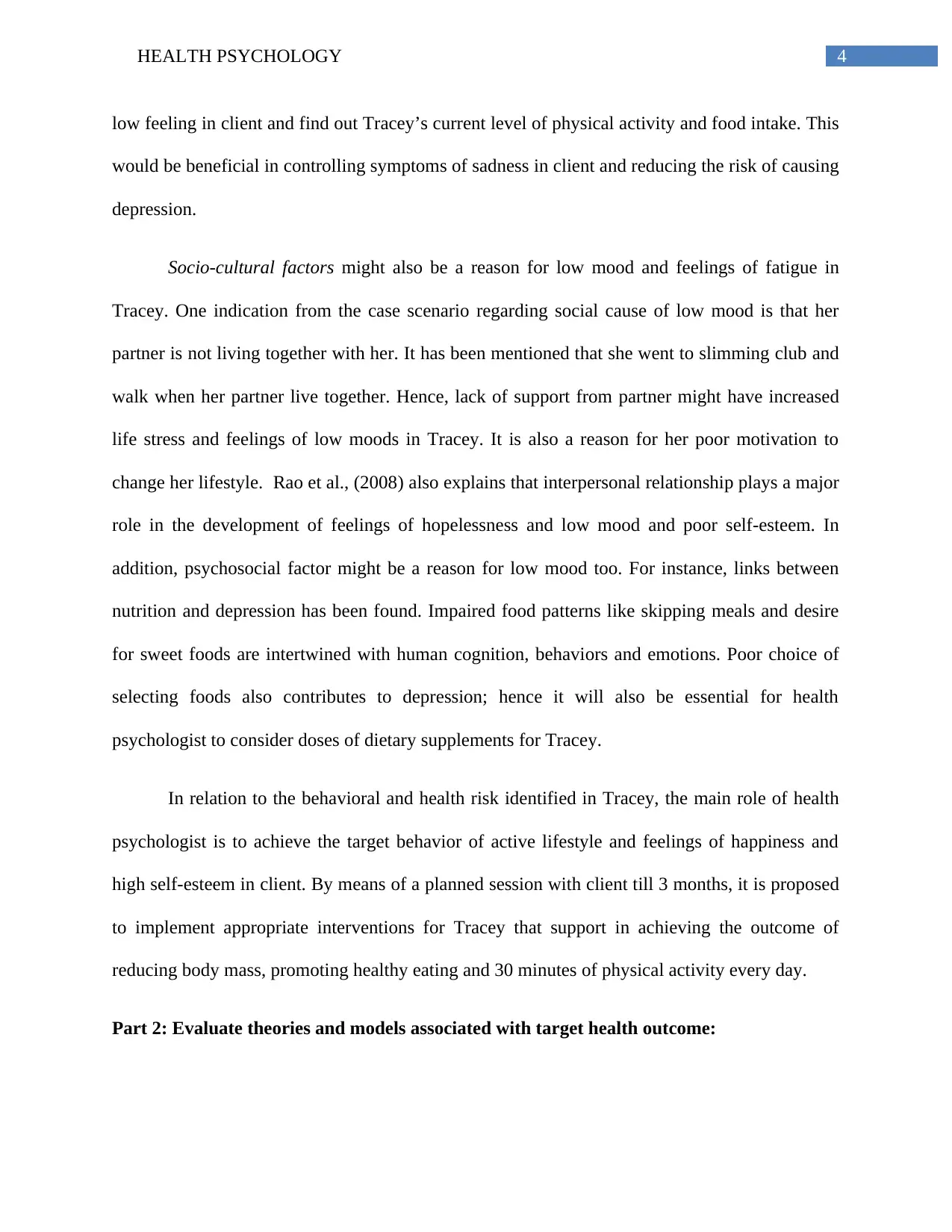
4HEALTH PSYCHOLOGY
low feeling in client and find out Tracey’s current level of physical activity and food intake. This
would be beneficial in controlling symptoms of sadness in client and reducing the risk of causing
depression.
Socio-cultural factors might also be a reason for low mood and feelings of fatigue in
Tracey. One indication from the case scenario regarding social cause of low mood is that her
partner is not living together with her. It has been mentioned that she went to slimming club and
walk when her partner live together. Hence, lack of support from partner might have increased
life stress and feelings of low moods in Tracey. It is also a reason for her poor motivation to
change her lifestyle. Rao et al., (2008) also explains that interpersonal relationship plays a major
role in the development of feelings of hopelessness and low mood and poor self-esteem. In
addition, psychosocial factor might be a reason for low mood too. For instance, links between
nutrition and depression has been found. Impaired food patterns like skipping meals and desire
for sweet foods are intertwined with human cognition, behaviors and emotions. Poor choice of
selecting foods also contributes to depression; hence it will also be essential for health
psychologist to consider doses of dietary supplements for Tracey.
In relation to the behavioral and health risk identified in Tracey, the main role of health
psychologist is to achieve the target behavior of active lifestyle and feelings of happiness and
high self-esteem in client. By means of a planned session with client till 3 months, it is proposed
to implement appropriate interventions for Tracey that support in achieving the outcome of
reducing body mass, promoting healthy eating and 30 minutes of physical activity every day.
Part 2: Evaluate theories and models associated with target health outcome:
low feeling in client and find out Tracey’s current level of physical activity and food intake. This
would be beneficial in controlling symptoms of sadness in client and reducing the risk of causing
depression.
Socio-cultural factors might also be a reason for low mood and feelings of fatigue in
Tracey. One indication from the case scenario regarding social cause of low mood is that her
partner is not living together with her. It has been mentioned that she went to slimming club and
walk when her partner live together. Hence, lack of support from partner might have increased
life stress and feelings of low moods in Tracey. It is also a reason for her poor motivation to
change her lifestyle. Rao et al., (2008) also explains that interpersonal relationship plays a major
role in the development of feelings of hopelessness and low mood and poor self-esteem. In
addition, psychosocial factor might be a reason for low mood too. For instance, links between
nutrition and depression has been found. Impaired food patterns like skipping meals and desire
for sweet foods are intertwined with human cognition, behaviors and emotions. Poor choice of
selecting foods also contributes to depression; hence it will also be essential for health
psychologist to consider doses of dietary supplements for Tracey.
In relation to the behavioral and health risk identified in Tracey, the main role of health
psychologist is to achieve the target behavior of active lifestyle and feelings of happiness and
high self-esteem in client. By means of a planned session with client till 3 months, it is proposed
to implement appropriate interventions for Tracey that support in achieving the outcome of
reducing body mass, promoting healthy eating and 30 minutes of physical activity every day.
Part 2: Evaluate theories and models associated with target health outcome:
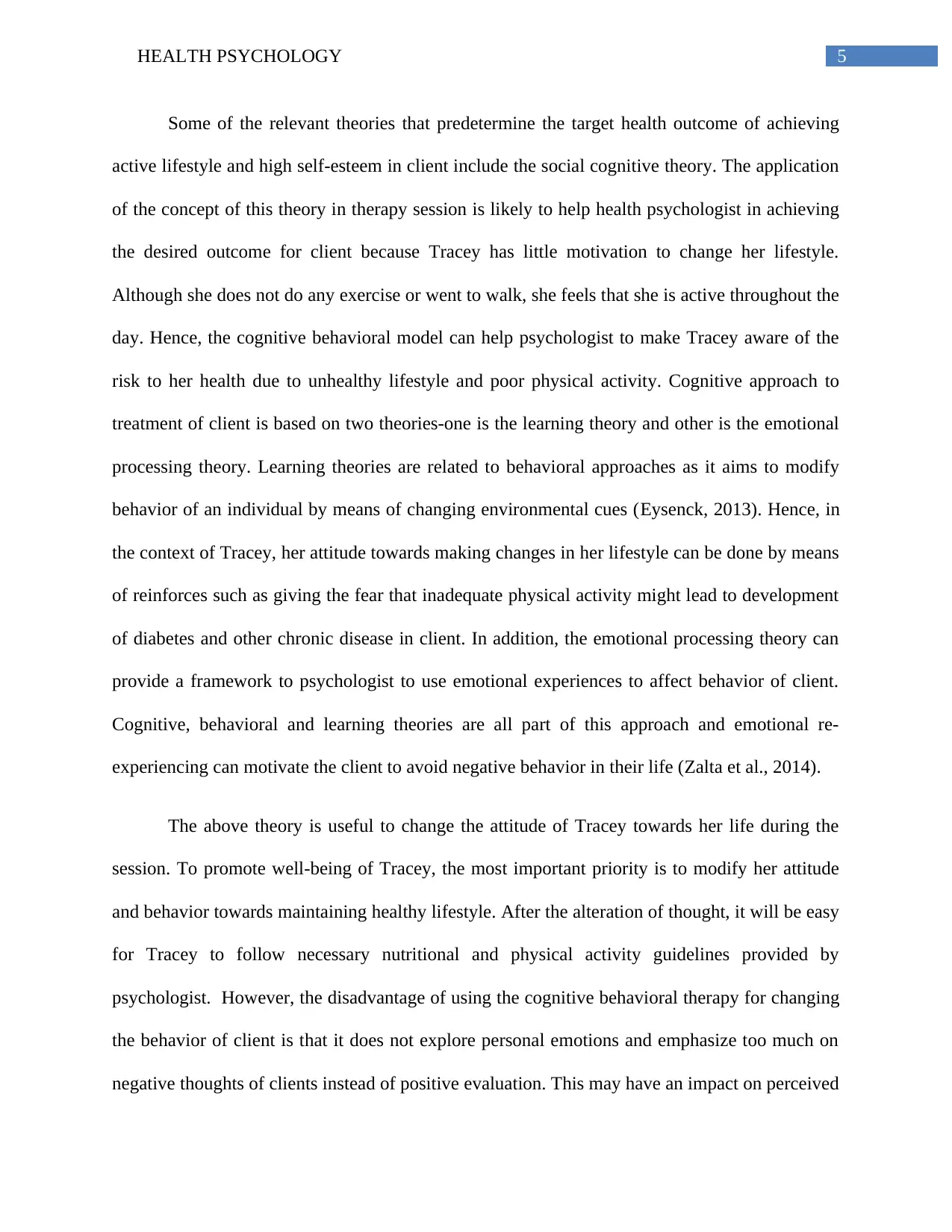
5HEALTH PSYCHOLOGY
Some of the relevant theories that predetermine the target health outcome of achieving
active lifestyle and high self-esteem in client include the social cognitive theory. The application
of the concept of this theory in therapy session is likely to help health psychologist in achieving
the desired outcome for client because Tracey has little motivation to change her lifestyle.
Although she does not do any exercise or went to walk, she feels that she is active throughout the
day. Hence, the cognitive behavioral model can help psychologist to make Tracey aware of the
risk to her health due to unhealthy lifestyle and poor physical activity. Cognitive approach to
treatment of client is based on two theories-one is the learning theory and other is the emotional
processing theory. Learning theories are related to behavioral approaches as it aims to modify
behavior of an individual by means of changing environmental cues (Eysenck, 2013). Hence, in
the context of Tracey, her attitude towards making changes in her lifestyle can be done by means
of reinforces such as giving the fear that inadequate physical activity might lead to development
of diabetes and other chronic disease in client. In addition, the emotional processing theory can
provide a framework to psychologist to use emotional experiences to affect behavior of client.
Cognitive, behavioral and learning theories are all part of this approach and emotional re-
experiencing can motivate the client to avoid negative behavior in their life (Zalta et al., 2014).
The above theory is useful to change the attitude of Tracey towards her life during the
session. To promote well-being of Tracey, the most important priority is to modify her attitude
and behavior towards maintaining healthy lifestyle. After the alteration of thought, it will be easy
for Tracey to follow necessary nutritional and physical activity guidelines provided by
psychologist. However, the disadvantage of using the cognitive behavioral therapy for changing
the behavior of client is that it does not explore personal emotions and emphasize too much on
negative thoughts of clients instead of positive evaluation. This may have an impact on perceived
Some of the relevant theories that predetermine the target health outcome of achieving
active lifestyle and high self-esteem in client include the social cognitive theory. The application
of the concept of this theory in therapy session is likely to help health psychologist in achieving
the desired outcome for client because Tracey has little motivation to change her lifestyle.
Although she does not do any exercise or went to walk, she feels that she is active throughout the
day. Hence, the cognitive behavioral model can help psychologist to make Tracey aware of the
risk to her health due to unhealthy lifestyle and poor physical activity. Cognitive approach to
treatment of client is based on two theories-one is the learning theory and other is the emotional
processing theory. Learning theories are related to behavioral approaches as it aims to modify
behavior of an individual by means of changing environmental cues (Eysenck, 2013). Hence, in
the context of Tracey, her attitude towards making changes in her lifestyle can be done by means
of reinforces such as giving the fear that inadequate physical activity might lead to development
of diabetes and other chronic disease in client. In addition, the emotional processing theory can
provide a framework to psychologist to use emotional experiences to affect behavior of client.
Cognitive, behavioral and learning theories are all part of this approach and emotional re-
experiencing can motivate the client to avoid negative behavior in their life (Zalta et al., 2014).
The above theory is useful to change the attitude of Tracey towards her life during the
session. To promote well-being of Tracey, the most important priority is to modify her attitude
and behavior towards maintaining healthy lifestyle. After the alteration of thought, it will be easy
for Tracey to follow necessary nutritional and physical activity guidelines provided by
psychologist. However, the disadvantage of using the cognitive behavioral therapy for changing
the behavior of client is that it does not explore personal emotions and emphasize too much on
negative thoughts of clients instead of positive evaluation. This may have an impact on perceived
⊘ This is a preview!⊘
Do you want full access?
Subscribe today to unlock all pages.

Trusted by 1+ million students worldwide
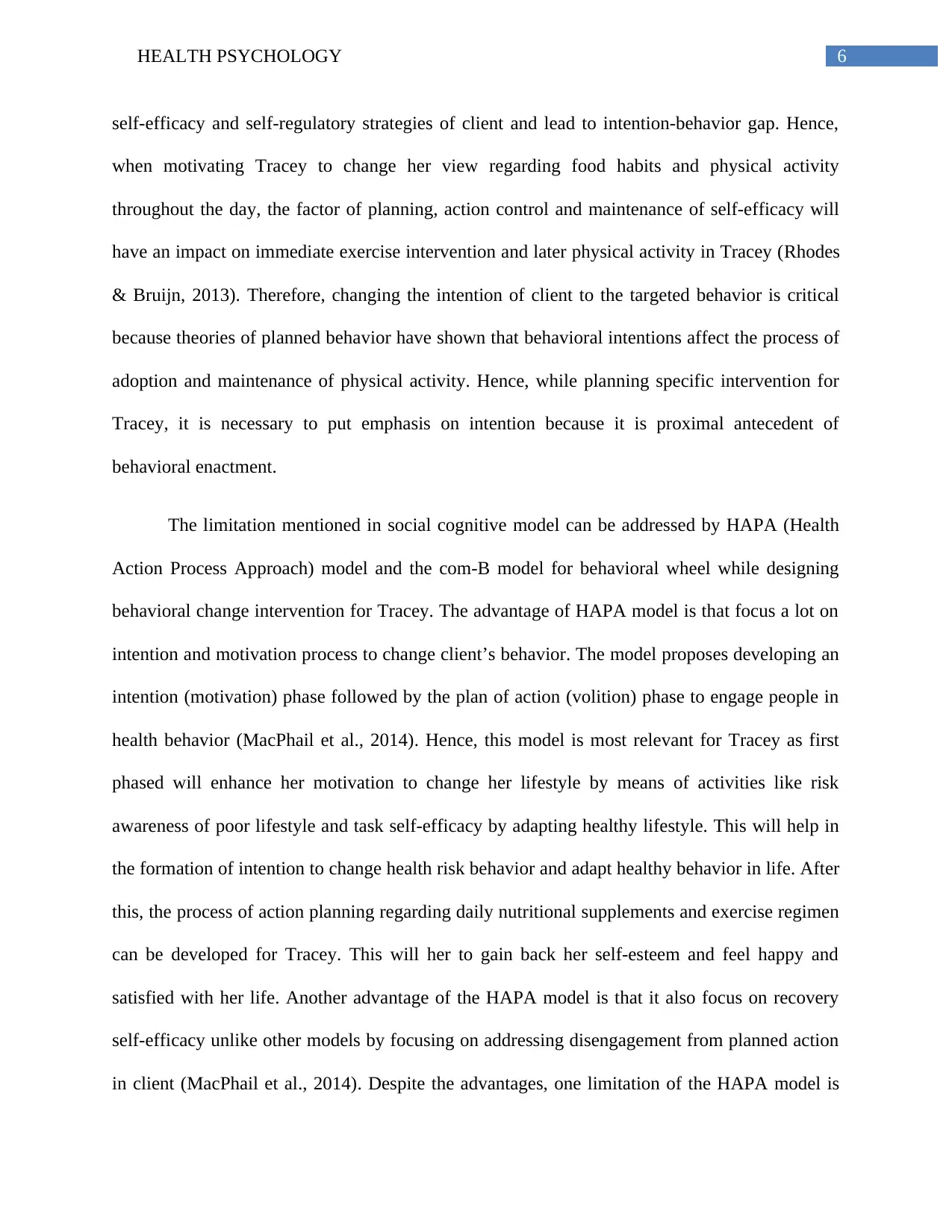
6HEALTH PSYCHOLOGY
self-efficacy and self-regulatory strategies of client and lead to intention-behavior gap. Hence,
when motivating Tracey to change her view regarding food habits and physical activity
throughout the day, the factor of planning, action control and maintenance of self-efficacy will
have an impact on immediate exercise intervention and later physical activity in Tracey (Rhodes
& Bruijn, 2013). Therefore, changing the intention of client to the targeted behavior is critical
because theories of planned behavior have shown that behavioral intentions affect the process of
adoption and maintenance of physical activity. Hence, while planning specific intervention for
Tracey, it is necessary to put emphasis on intention because it is proximal antecedent of
behavioral enactment.
The limitation mentioned in social cognitive model can be addressed by HAPA (Health
Action Process Approach) model and the com-B model for behavioral wheel while designing
behavioral change intervention for Tracey. The advantage of HAPA model is that focus a lot on
intention and motivation process to change client’s behavior. The model proposes developing an
intention (motivation) phase followed by the plan of action (volition) phase to engage people in
health behavior (MacPhail et al., 2014). Hence, this model is most relevant for Tracey as first
phased will enhance her motivation to change her lifestyle by means of activities like risk
awareness of poor lifestyle and task self-efficacy by adapting healthy lifestyle. This will help in
the formation of intention to change health risk behavior and adapt healthy behavior in life. After
this, the process of action planning regarding daily nutritional supplements and exercise regimen
can be developed for Tracey. This will her to gain back her self-esteem and feel happy and
satisfied with her life. Another advantage of the HAPA model is that it also focus on recovery
self-efficacy unlike other models by focusing on addressing disengagement from planned action
in client (MacPhail et al., 2014). Despite the advantages, one limitation of the HAPA model is
self-efficacy and self-regulatory strategies of client and lead to intention-behavior gap. Hence,
when motivating Tracey to change her view regarding food habits and physical activity
throughout the day, the factor of planning, action control and maintenance of self-efficacy will
have an impact on immediate exercise intervention and later physical activity in Tracey (Rhodes
& Bruijn, 2013). Therefore, changing the intention of client to the targeted behavior is critical
because theories of planned behavior have shown that behavioral intentions affect the process of
adoption and maintenance of physical activity. Hence, while planning specific intervention for
Tracey, it is necessary to put emphasis on intention because it is proximal antecedent of
behavioral enactment.
The limitation mentioned in social cognitive model can be addressed by HAPA (Health
Action Process Approach) model and the com-B model for behavioral wheel while designing
behavioral change intervention for Tracey. The advantage of HAPA model is that focus a lot on
intention and motivation process to change client’s behavior. The model proposes developing an
intention (motivation) phase followed by the plan of action (volition) phase to engage people in
health behavior (MacPhail et al., 2014). Hence, this model is most relevant for Tracey as first
phased will enhance her motivation to change her lifestyle by means of activities like risk
awareness of poor lifestyle and task self-efficacy by adapting healthy lifestyle. This will help in
the formation of intention to change health risk behavior and adapt healthy behavior in life. After
this, the process of action planning regarding daily nutritional supplements and exercise regimen
can be developed for Tracey. This will her to gain back her self-esteem and feel happy and
satisfied with her life. Another advantage of the HAPA model is that it also focus on recovery
self-efficacy unlike other models by focusing on addressing disengagement from planned action
in client (MacPhail et al., 2014). Despite the advantages, one limitation of the HAPA model is
Paraphrase This Document
Need a fresh take? Get an instant paraphrase of this document with our AI Paraphraser
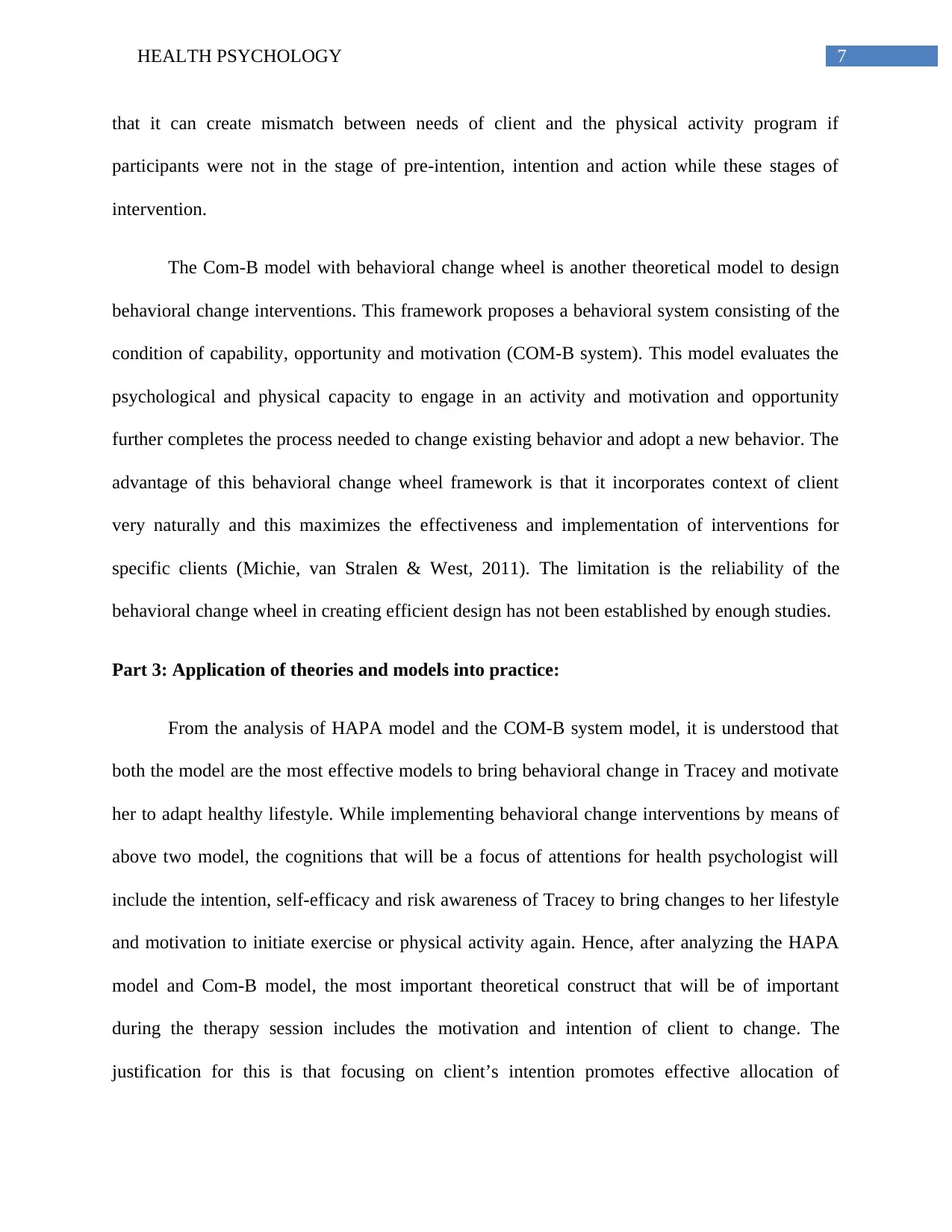
7HEALTH PSYCHOLOGY
that it can create mismatch between needs of client and the physical activity program if
participants were not in the stage of pre-intention, intention and action while these stages of
intervention.
The Com-B model with behavioral change wheel is another theoretical model to design
behavioral change interventions. This framework proposes a behavioral system consisting of the
condition of capability, opportunity and motivation (COM-B system). This model evaluates the
psychological and physical capacity to engage in an activity and motivation and opportunity
further completes the process needed to change existing behavior and adopt a new behavior. The
advantage of this behavioral change wheel framework is that it incorporates context of client
very naturally and this maximizes the effectiveness and implementation of interventions for
specific clients (Michie, van Stralen & West, 2011). The limitation is the reliability of the
behavioral change wheel in creating efficient design has not been established by enough studies.
Part 3: Application of theories and models into practice:
From the analysis of HAPA model and the COM-B system model, it is understood that
both the model are the most effective models to bring behavioral change in Tracey and motivate
her to adapt healthy lifestyle. While implementing behavioral change interventions by means of
above two model, the cognitions that will be a focus of attentions for health psychologist will
include the intention, self-efficacy and risk awareness of Tracey to bring changes to her lifestyle
and motivation to initiate exercise or physical activity again. Hence, after analyzing the HAPA
model and Com-B model, the most important theoretical construct that will be of important
during the therapy session includes the motivation and intention of client to change. The
justification for this is that focusing on client’s intention promotes effective allocation of
that it can create mismatch between needs of client and the physical activity program if
participants were not in the stage of pre-intention, intention and action while these stages of
intervention.
The Com-B model with behavioral change wheel is another theoretical model to design
behavioral change interventions. This framework proposes a behavioral system consisting of the
condition of capability, opportunity and motivation (COM-B system). This model evaluates the
psychological and physical capacity to engage in an activity and motivation and opportunity
further completes the process needed to change existing behavior and adopt a new behavior. The
advantage of this behavioral change wheel framework is that it incorporates context of client
very naturally and this maximizes the effectiveness and implementation of interventions for
specific clients (Michie, van Stralen & West, 2011). The limitation is the reliability of the
behavioral change wheel in creating efficient design has not been established by enough studies.
Part 3: Application of theories and models into practice:
From the analysis of HAPA model and the COM-B system model, it is understood that
both the model are the most effective models to bring behavioral change in Tracey and motivate
her to adapt healthy lifestyle. While implementing behavioral change interventions by means of
above two model, the cognitions that will be a focus of attentions for health psychologist will
include the intention, self-efficacy and risk awareness of Tracey to bring changes to her lifestyle
and motivation to initiate exercise or physical activity again. Hence, after analyzing the HAPA
model and Com-B model, the most important theoretical construct that will be of important
during the therapy session includes the motivation and intention of client to change. The
justification for this is that focusing on client’s intention promotes effective allocation of
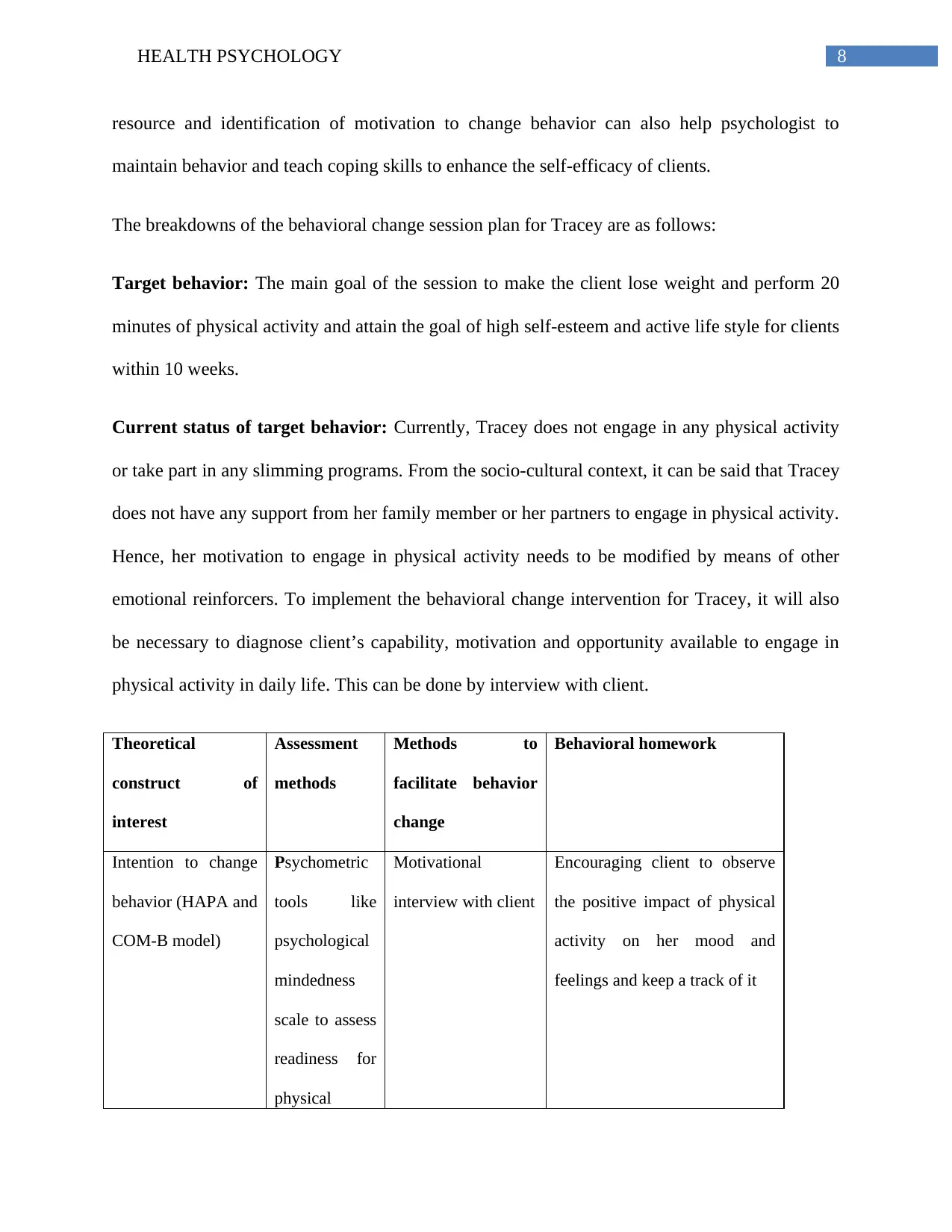
8HEALTH PSYCHOLOGY
resource and identification of motivation to change behavior can also help psychologist to
maintain behavior and teach coping skills to enhance the self-efficacy of clients.
The breakdowns of the behavioral change session plan for Tracey are as follows:
Target behavior: The main goal of the session to make the client lose weight and perform 20
minutes of physical activity and attain the goal of high self-esteem and active life style for clients
within 10 weeks.
Current status of target behavior: Currently, Tracey does not engage in any physical activity
or take part in any slimming programs. From the socio-cultural context, it can be said that Tracey
does not have any support from her family member or her partners to engage in physical activity.
Hence, her motivation to engage in physical activity needs to be modified by means of other
emotional reinforcers. To implement the behavioral change intervention for Tracey, it will also
be necessary to diagnose client’s capability, motivation and opportunity available to engage in
physical activity in daily life. This can be done by interview with client.
Theoretical
construct of
interest
Assessment
methods
Methods to
facilitate behavior
change
Behavioral homework
Intention to change
behavior (HAPA and
COM-B model)
Psychometric
tools like
psychological
mindedness
scale to assess
readiness for
physical
Motivational
interview with client
Encouraging client to observe
the positive impact of physical
activity on her mood and
feelings and keep a track of it
resource and identification of motivation to change behavior can also help psychologist to
maintain behavior and teach coping skills to enhance the self-efficacy of clients.
The breakdowns of the behavioral change session plan for Tracey are as follows:
Target behavior: The main goal of the session to make the client lose weight and perform 20
minutes of physical activity and attain the goal of high self-esteem and active life style for clients
within 10 weeks.
Current status of target behavior: Currently, Tracey does not engage in any physical activity
or take part in any slimming programs. From the socio-cultural context, it can be said that Tracey
does not have any support from her family member or her partners to engage in physical activity.
Hence, her motivation to engage in physical activity needs to be modified by means of other
emotional reinforcers. To implement the behavioral change intervention for Tracey, it will also
be necessary to diagnose client’s capability, motivation and opportunity available to engage in
physical activity in daily life. This can be done by interview with client.
Theoretical
construct of
interest
Assessment
methods
Methods to
facilitate behavior
change
Behavioral homework
Intention to change
behavior (HAPA and
COM-B model)
Psychometric
tools like
psychological
mindedness
scale to assess
readiness for
physical
Motivational
interview with client
Encouraging client to observe
the positive impact of physical
activity on her mood and
feelings and keep a track of it
⊘ This is a preview!⊘
Do you want full access?
Subscribe today to unlock all pages.

Trusted by 1+ million students worldwide
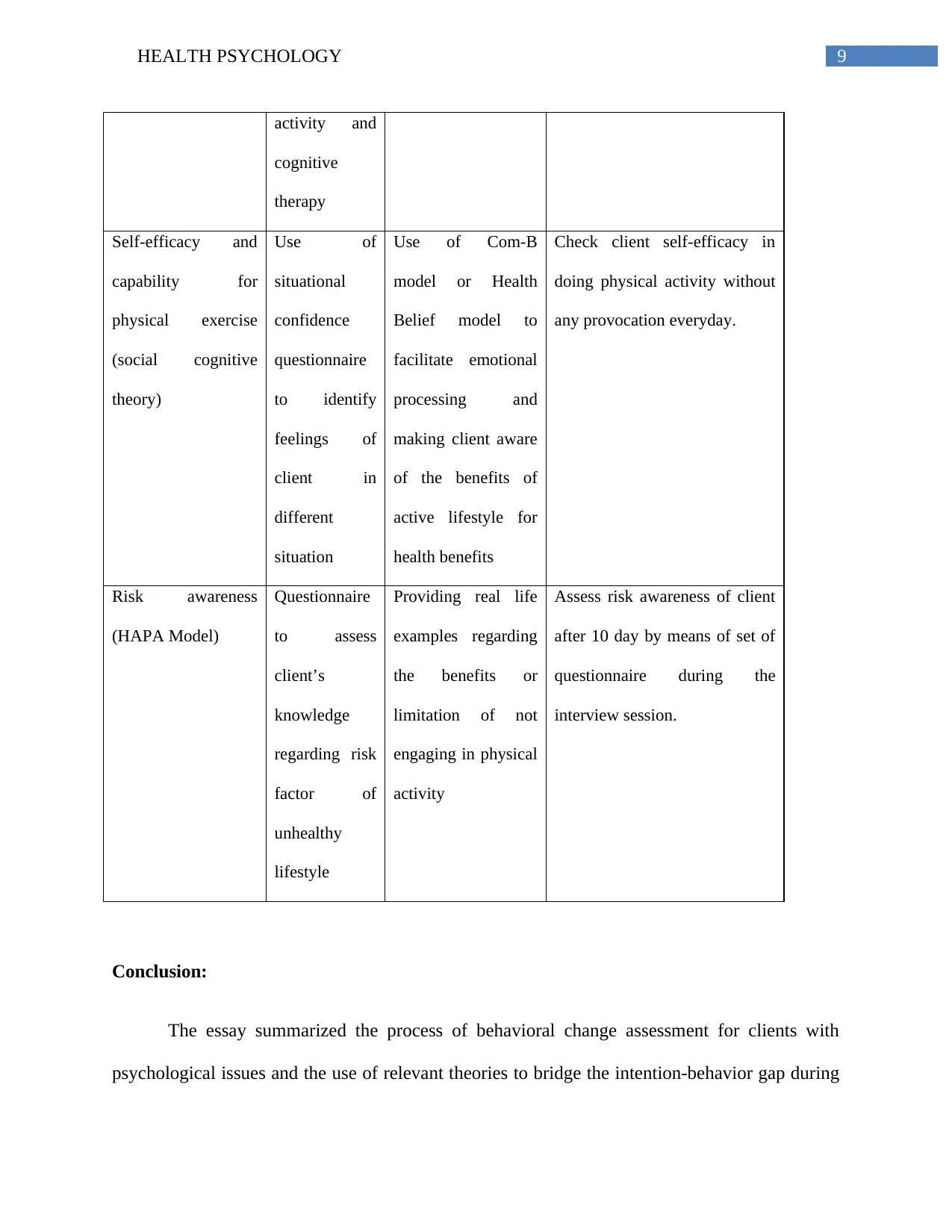
9HEALTH PSYCHOLOGY
activity and
cognitive
therapy
Self-efficacy and
capability for
physical exercise
(social cognitive
theory)
Use of
situational
confidence
questionnaire
to identify
feelings of
client in
different
situation
Use of Com-B
model or Health
Belief model to
facilitate emotional
processing and
making client aware
of the benefits of
active lifestyle for
health benefits
Check client self-efficacy in
doing physical activity without
any provocation everyday.
Risk awareness
(HAPA Model)
Questionnaire
to assess
client’s
knowledge
regarding risk
factor of
unhealthy
lifestyle
Providing real life
examples regarding
the benefits or
limitation of not
engaging in physical
activity
Assess risk awareness of client
after 10 day by means of set of
questionnaire during the
interview session.
Conclusion:
The essay summarized the process of behavioral change assessment for clients with
psychological issues and the use of relevant theories to bridge the intention-behavior gap during
activity and
cognitive
therapy
Self-efficacy and
capability for
physical exercise
(social cognitive
theory)
Use of
situational
confidence
questionnaire
to identify
feelings of
client in
different
situation
Use of Com-B
model or Health
Belief model to
facilitate emotional
processing and
making client aware
of the benefits of
active lifestyle for
health benefits
Check client self-efficacy in
doing physical activity without
any provocation everyday.
Risk awareness
(HAPA Model)
Questionnaire
to assess
client’s
knowledge
regarding risk
factor of
unhealthy
lifestyle
Providing real life
examples regarding
the benefits or
limitation of not
engaging in physical
activity
Assess risk awareness of client
after 10 day by means of set of
questionnaire during the
interview session.
Conclusion:
The essay summarized the process of behavioral change assessment for clients with
psychological issues and the use of relevant theories to bridge the intention-behavior gap during
Paraphrase This Document
Need a fresh take? Get an instant paraphrase of this document with our AI Paraphraser
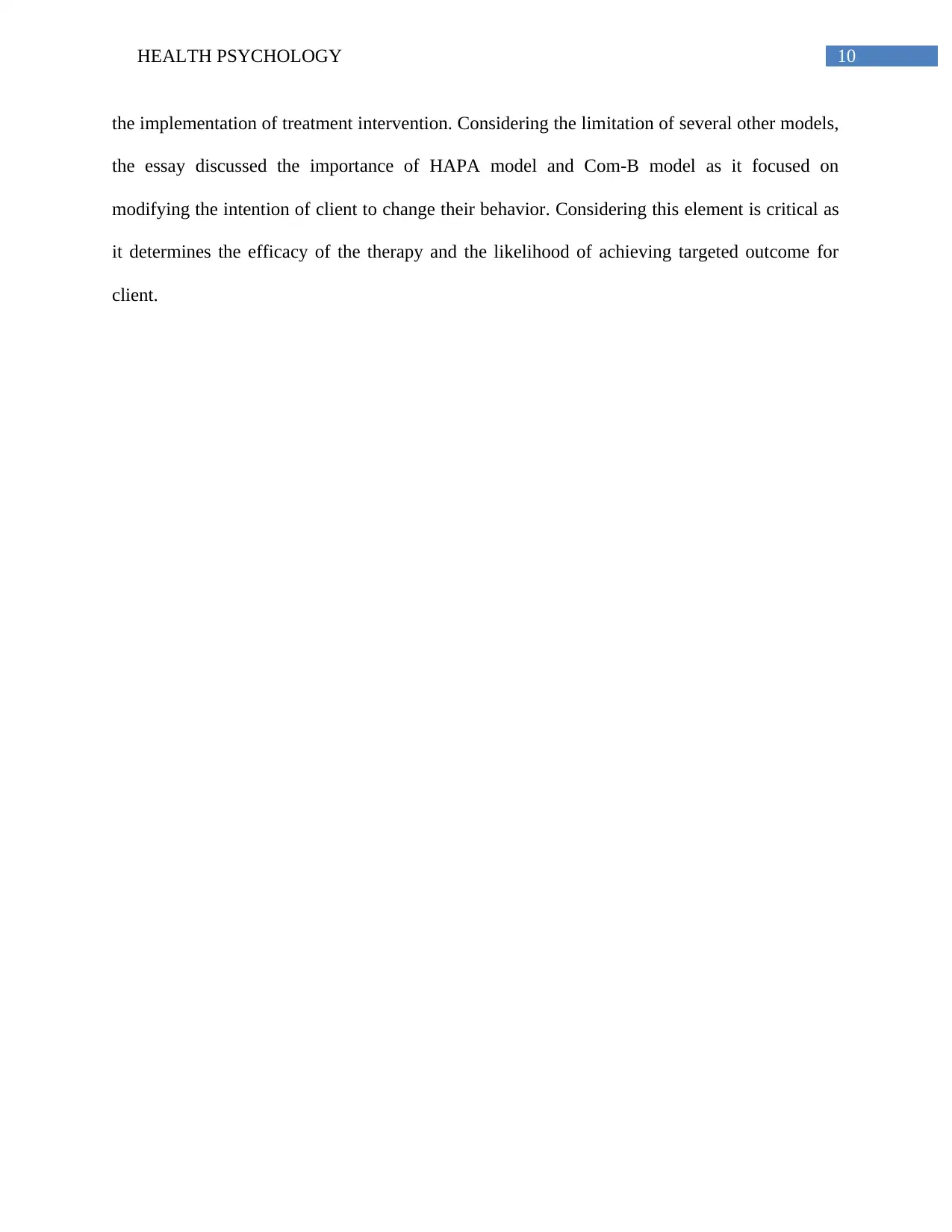
10HEALTH PSYCHOLOGY
the implementation of treatment intervention. Considering the limitation of several other models,
the essay discussed the importance of HAPA model and Com-B model as it focused on
modifying the intention of client to change their behavior. Considering this element is critical as
it determines the efficacy of the therapy and the likelihood of achieving targeted outcome for
client.
the implementation of treatment intervention. Considering the limitation of several other models,
the essay discussed the importance of HAPA model and Com-B model as it focused on
modifying the intention of client to change their behavior. Considering this element is critical as
it determines the efficacy of the therapy and the likelihood of achieving targeted outcome for
client.
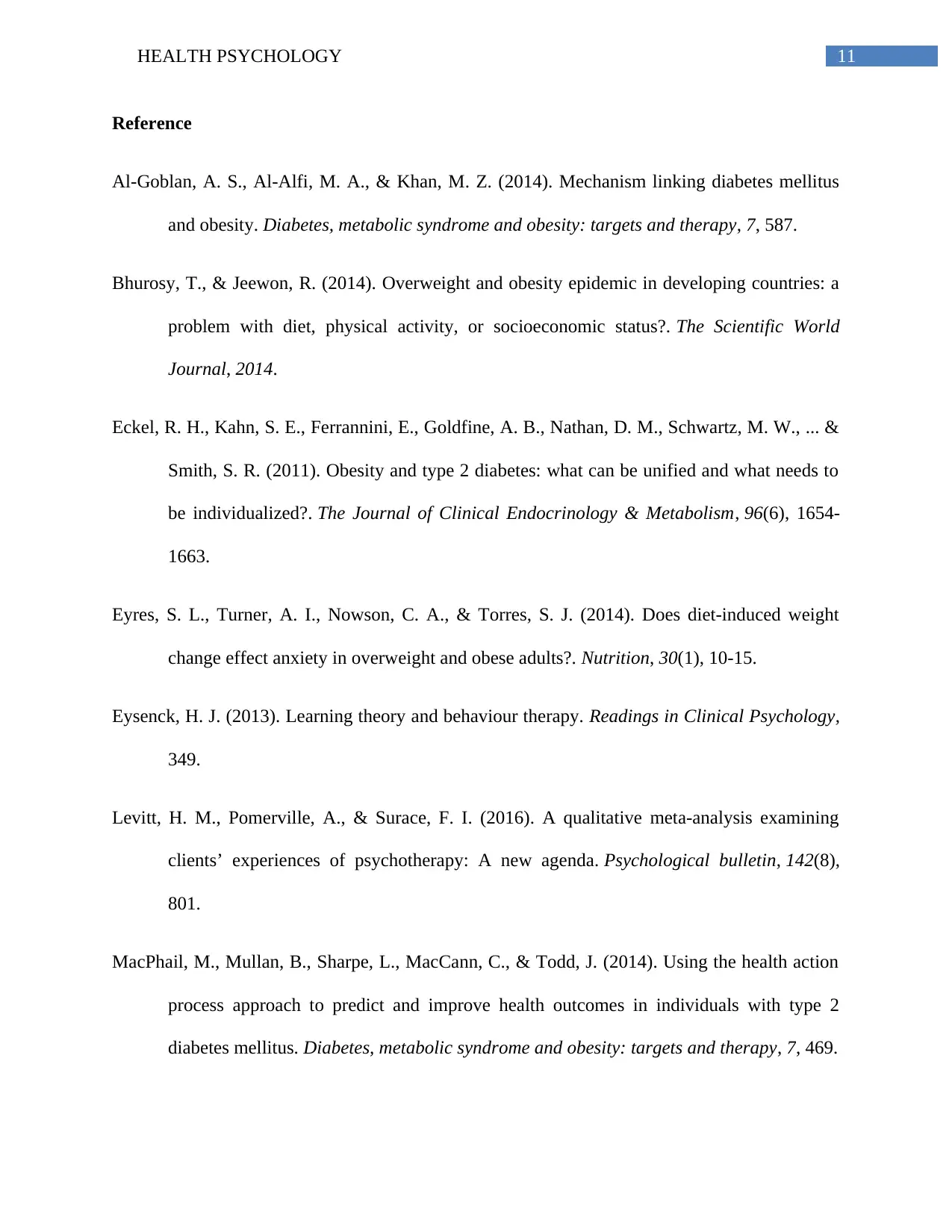
11HEALTH PSYCHOLOGY
Reference
Al-Goblan, A. S., Al-Alfi, M. A., & Khan, M. Z. (2014). Mechanism linking diabetes mellitus
and obesity. Diabetes, metabolic syndrome and obesity: targets and therapy, 7, 587.
Bhurosy, T., & Jeewon, R. (2014). Overweight and obesity epidemic in developing countries: a
problem with diet, physical activity, or socioeconomic status?. The Scientific World
Journal, 2014.
Eckel, R. H., Kahn, S. E., Ferrannini, E., Goldfine, A. B., Nathan, D. M., Schwartz, M. W., ... &
Smith, S. R. (2011). Obesity and type 2 diabetes: what can be unified and what needs to
be individualized?. The Journal of Clinical Endocrinology & Metabolism, 96(6), 1654-
1663.
Eyres, S. L., Turner, A. I., Nowson, C. A., & Torres, S. J. (2014). Does diet-induced weight
change effect anxiety in overweight and obese adults?. Nutrition, 30(1), 10-15.
Eysenck, H. J. (2013). Learning theory and behaviour therapy. Readings in Clinical Psychology,
349.
Levitt, H. M., Pomerville, A., & Surace, F. I. (2016). A qualitative meta-analysis examining
clients’ experiences of psychotherapy: A new agenda. Psychological bulletin, 142(8),
801.
MacPhail, M., Mullan, B., Sharpe, L., MacCann, C., & Todd, J. (2014). Using the health action
process approach to predict and improve health outcomes in individuals with type 2
diabetes mellitus. Diabetes, metabolic syndrome and obesity: targets and therapy, 7, 469.
Reference
Al-Goblan, A. S., Al-Alfi, M. A., & Khan, M. Z. (2014). Mechanism linking diabetes mellitus
and obesity. Diabetes, metabolic syndrome and obesity: targets and therapy, 7, 587.
Bhurosy, T., & Jeewon, R. (2014). Overweight and obesity epidemic in developing countries: a
problem with diet, physical activity, or socioeconomic status?. The Scientific World
Journal, 2014.
Eckel, R. H., Kahn, S. E., Ferrannini, E., Goldfine, A. B., Nathan, D. M., Schwartz, M. W., ... &
Smith, S. R. (2011). Obesity and type 2 diabetes: what can be unified and what needs to
be individualized?. The Journal of Clinical Endocrinology & Metabolism, 96(6), 1654-
1663.
Eyres, S. L., Turner, A. I., Nowson, C. A., & Torres, S. J. (2014). Does diet-induced weight
change effect anxiety in overweight and obese adults?. Nutrition, 30(1), 10-15.
Eysenck, H. J. (2013). Learning theory and behaviour therapy. Readings in Clinical Psychology,
349.
Levitt, H. M., Pomerville, A., & Surace, F. I. (2016). A qualitative meta-analysis examining
clients’ experiences of psychotherapy: A new agenda. Psychological bulletin, 142(8),
801.
MacPhail, M., Mullan, B., Sharpe, L., MacCann, C., & Todd, J. (2014). Using the health action
process approach to predict and improve health outcomes in individuals with type 2
diabetes mellitus. Diabetes, metabolic syndrome and obesity: targets and therapy, 7, 469.
⊘ This is a preview!⊘
Do you want full access?
Subscribe today to unlock all pages.

Trusted by 1+ million students worldwide
1 out of 12
Related Documents
Your All-in-One AI-Powered Toolkit for Academic Success.
+13062052269
info@desklib.com
Available 24*7 on WhatsApp / Email
![[object Object]](/_next/static/media/star-bottom.7253800d.svg)
Unlock your academic potential
Copyright © 2020–2025 A2Z Services. All Rights Reserved. Developed and managed by ZUCOL.





